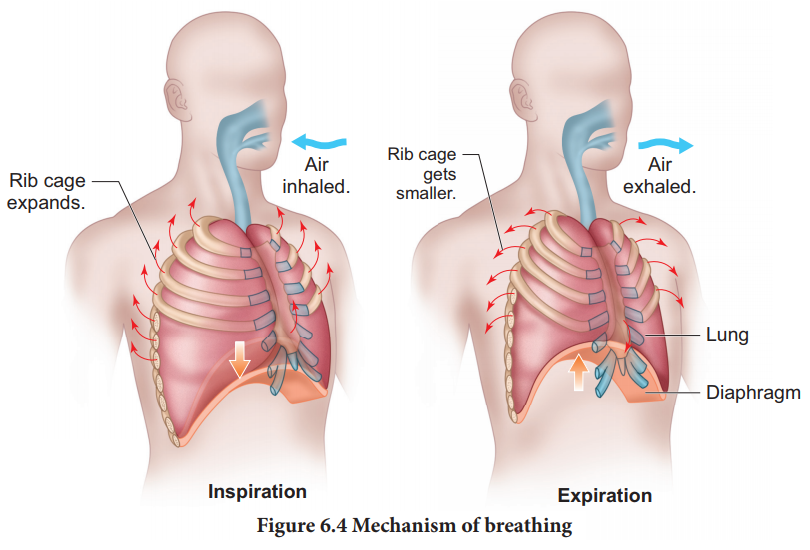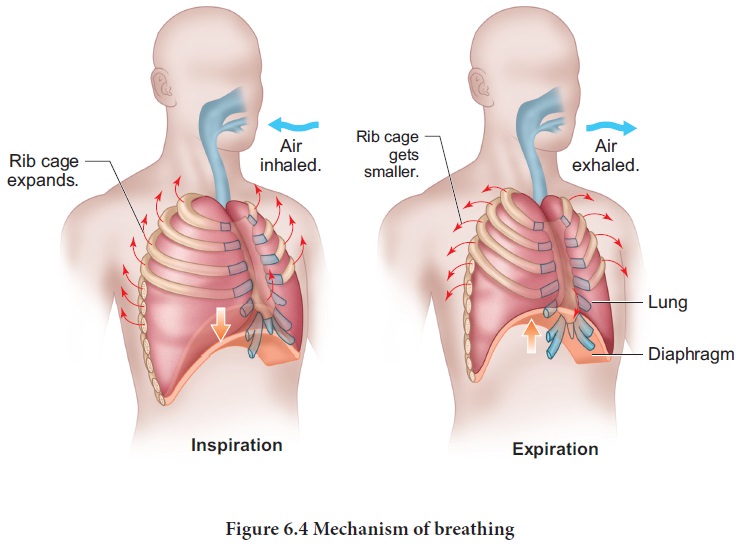Chapter: 11th Zoology : Chapter 6 : Respiration
Mechanism of breathing

Mechanism of
breathing
The
movement of air between the atmosphere and the lungs is known as ventilation or
breathing. Inspiration and expiration are the two phases of breathing.
Inspiration is the movement of atmospheric air into the lungs and expiration is
the movement of alveolar air that diffuse out of the lungs. (Figure 6.4)
Lungs do
not contain muscle fibres but expands and contracts by the movement of the ribs
and diaphragm. The diaphragm is a sheet of tissue which separates the thorax
from the abdomen. In a relaxed state, the diaphragm is domed shaped.
Ribs are moved by the intercostal muscles. External and internal intercostal muscles found between the ribs and the diaphragm helps in creating pressure gradients. Inspiration occurs if the pressure inside the lungs (intrapulmonary pressure) is less than the atmospheric pressure likewise expiration takes place when the pressure within the lungs is higher than the atmospheric pressure.
Inspiraton
is initiated by the -contraction of the diaphragm muscles and external
intercostal muscles, which pulls the ribs and sternum upwards and outwards and
increases the volume of the thoracic chamber in the dorso–ventral axis, forcing
the lungs to expand the pulmonary volume. The increase in pulmonary volume and
decrease in the intrapulmonary pressure forces the fresh air from outside to
enter the air passages into the lungs to equalize the pressure. This process-
is called inspiration.
Relaxation
of the diaphragm allows the diaphragm and sternum to return- to its dome shape
and the internal -intercostal muscles contract, pulling the ribs
downward-
reducing the thoracic volume and pulmonary volume. This results in an increase
in the intrapulmonary pressure slightly above the atmospheric -pressure causing
the expulsion of air from the lungs. This process is called expiration.
![]()
Onanaverage,ahealthyhumanbreathes
12–16 times/minute. An instrument called Spirometer is used to measure the
volume of air involved in breathing movements for clinical assessment of a
person’s pulmonary function.
Respiratory volumes and capacities
The
volume of air present in various phases of respiration is denoted as
Respiratory volumes: (Figure 6.5)
• Tidal Volume (TV) Tidal
volume is the amount of air inspired or expired with each normal breath. It is approximately 500 mL., i.e. a normal human
adult can inspire or expire approximately 6000 to 8000mL of air per minute.
During vigorous exercise, the tidal volume is about 4–10 times higher.

•
Inspiratory
Reserve volume (IRV) Additional volume of air a person can inspire by forceful inspiration is
called Inspiratory Reserve Volume. The normal value is 2500–3000 mL.
•
Expiratory
Reserve volume (ERV) Additional volume of air a person can forcefully exhale by forceful
expiration is called Expiratory Reserve Volume. The normal value is 1000–1100
mL.
•
Residual
Volume (RV) The volume of air remaining in the lungs after a forceful expiration. It is
approximately 1100–1200 mL.
Respiratory capacities:
•
Vital
capacity (VC) the maximum volume of air that can be moved out during a single breath following a
maximal inspiration. A person first inspires maximally then expires maximally.
VC=ERV+TV+IRV
•
Inspiratory
capacity (IC) The total volume of air a person can inhale after normal expiration. It includes
tidal volume and inspiratory reserve volume. IC=TV+IRV
•
Expiratory
capacity (EC) The total volume of air a person can exhale after normal inspiration. It
includes tidal volume and expiratory reserve volume. EC=TV+ERV
•
Total
Lung Capacity (TLC) The total volume of air which the lungs can accommodate after forced
inspiration is called Total Lung Capacity. This includes- the vital capacity
and the residual volume. It is approximately 6000mL. TLC=VC+RV
•
Minute
Respiratory Volume The amount of air that moves into the respiratory passage per minute is
called minute respiratory volume.
Normal TV
= 500mL; Normal respiratory rate = 12 times/minute
Therefore,
minute respiratory- volume = 6 Litres/minute (for a -normal healthy man).
Dead space
Some of
the inspired air never reaches the gas exchange areas but fills the respiratory
passages where exchange of gases does not occur. This air is called dead space.
Dead
space is not involved in gaseous exchange. It amounts to approximately 150mL.
Related Topics
